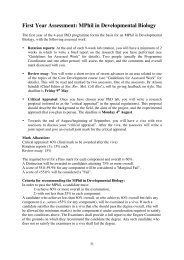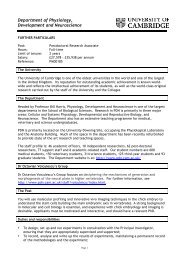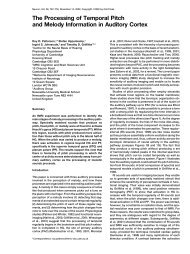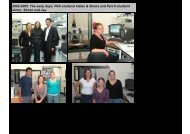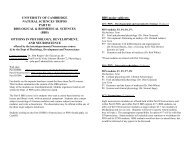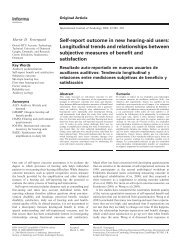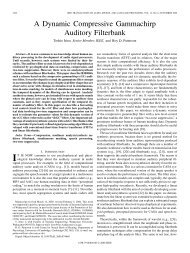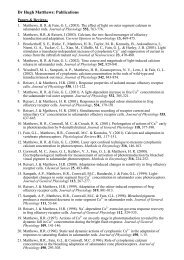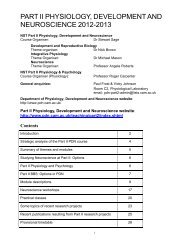FRIDAY MORNING, 20 MAY 2005 REGENCY E, 8:30 A.M. TO 12:00 ...
FRIDAY MORNING, 20 MAY 2005 REGENCY E, 8:30 A.M. TO 12:00 ...
FRIDAY MORNING, 20 MAY 2005 REGENCY E, 8:30 A.M. TO 12:00 ...
Create successful ePaper yourself
Turn your PDF publications into a flip-book with our unique Google optimized e-Paper software.
9:<strong>00</strong><br />
5aBBa5. Image-guided high intensity focused ultrasound annular<br />
array for hemostasis and tumor treatment. Vesna Zderic, Robert<br />
Held, Thuc Nguyen, and Shahram Vaezy Appl. Phys. Lab. and<br />
Bioengineering, Univ. of Washington, 1013 NE 40th St., Seattle, WA<br />
98105, vesna@u.washington.edu<br />
To develop and characterize an ultrasound-guided high intensity focused<br />
ultrasound HIFU array, an 11-element annular phased array aperture<br />
of 3.56.0 cm, focal depth of 3.0–6.0 cm, frequency of 3 MHz was<br />
coupled to an imaging probe C9-5, Philips. LabView software was developed<br />
to control driving electronics and image guidance. Radiation force<br />
balance measurements, Schlieren imaging, and hydrophone field mapping<br />
were performed. Lesions were produced in gel phantoms, and ex vivo<br />
porcine liver and human cancerous uterus. The lesions were formed beginning<br />
at a focal depth of 6.0 cm and moving by 0.5 cm increments to 3.0<br />
cm, and vice versa, with the overall treatment time of 2 min. The transducer<br />
had efficiency of 38%, with intensities of up to 6<strong>20</strong>0 W/cm 2 at the<br />
natural focus of 5 cm, in water. The 6 dB focal area varied from 0.4 mm 2<br />
at3cm to 1.5 mm 2 at6cm. The 3 to 6 cm tissue lesions were 2.7<br />
0.5 cm in length, compared to 4.10.3 cm for the 6 to 3 cm lesions.<br />
The average lesion width was 1 cm. Image-guided HIFU array may enable<br />
treatment of large tumor volumes and hemorrhage control at different<br />
depths inside the body.<br />
9:15<br />
5aBBa6. Image guided acoustic hemostasis. Sean Burgess Dept. of<br />
Bioengineering, Univ. of Washington, Box 355640, 1013 NE 40th St.,<br />
Seattle, WA 98105, sburgess@u.washington.edu, Vesna Zderic Univ. of<br />
Washington, and Shahram Vaezy Univ. of Washington<br />
Previous studies have shown that high intensity focused ultrasound<br />
HIFU can successfully control visible bleeding from solid organ injuries.<br />
This study investigates the ability of ultrasound image-guided HIFU to<br />
arrest occult hemorrhaging in the posterior liver parenchyma using a pig<br />
model. The image-guided HIFU device consisted of an intraoperative imaging<br />
probe and a spherically-curved HIFU transducer with focal length of<br />
3.5 cm, frequency of 3.23 MHz, and focal acoustic intensity of<br />
2350 W/cm 2 . A total of 19 incisions 14 HIFU-treated and 5 control incisions<br />
were made in five pig livers. The incisions were <strong>30</strong> mm long and 7<br />
mm deep with HIFU application occurring within <strong>20</strong> s of making an<br />
incision. Hemostasis was achieved in all treated incisions after a mean <br />
SD of 6515 s of HIFU application. The mean blood loss rate of the<br />
control incisions initially and after seven minutes was 0.268 and 0.231<br />
mL/s, respectively. Subsequent histological analysis showed coagulative<br />
necrosis of liver tissue around the incision which appeared to be responsible<br />
for hemostasis. Ultrasound image-guided HIFU offers a promising<br />
method for achieving hemostasis in surgical settings in which the hemorrhage<br />
site is not accessible.<br />
9:<strong>30</strong><br />
5aBBa7. Ultrasound-guided high frequency focused ultrasound<br />
neurolysis of peripheral nerves to treat spasticity and pain. Jessica L.<br />
Foley, Frank L. StarrIII, Carie Frantz, Shahram Vaezy Ctr. for Industrial<br />
and Medical Ultrasound, Univ. of Washington, 1013 NE 40th St., Seattle,<br />
WA 98105, jlf2@u.washington.edu, Jessica L. Foley, Shahram Vaezy<br />
Univ. of Washington, Seattle, WA 98195, and James W. Little Univ. of<br />
Washington, Seattle, WA 98195<br />
Spasticity, a complication of central nervous system disorders, signified<br />
by uncontrollable muscle contractions, is difficult to treat effectively.<br />
The use of ultrasound image-guided high-intensity focused ultrasound<br />
HIFU to target and suppress the function of the sciatic nerve of rabbits in<br />
vivo, as a possible treatment of spasticity and pain, will be presented. The<br />
image-guided HIFU device included a 3.2-MHz spherically-curved transducer<br />
and an intraoperative imaging probe. A focal intensity of<br />
14801850 W/cm 2 was effective in achieving complete conduction block<br />
in 1<strong>00</strong>% of 22 nerves with HIFU treatment times of 3614 s (mean<br />
SD). Gross examination showed blanching of the nerve at the treatment<br />
site and lesion volumes of 2.81.4 cm 3 encompassing the nerve. Histological<br />
examination indicated axonal demyelination and necrosis of<br />
Schwann cells as probable mechanisms of nerve block. Long-term studies<br />
showed that HIFU intensity of 19<strong>30</strong> W/cm 2 , applied to <strong>12</strong> nerves for an<br />
average time of 10.54.9 s, enabled nerve blocks that remained for at<br />
least 7–14 days after HIFU treatment. Histological examination showed<br />
degeneration of axons distal to the HIFU treatment site. With accurate<br />
localization and targeting of peripheral nerves using ultrasound imaging,<br />
HIFU could become a promising tool for the suppression of spasticity and<br />
pain.<br />
9:45<br />
5aBBa8. Percutaneous high intensity focused ultrasound on pigs.<br />
Herman du Plessis Surgery, 1 Military Hospital, Thaba Tshwane 0143,<br />
South Africa and Shahram Vaezy Univ. of Washington, Seattle, WA<br />
98195<br />
Two types of HIFU Handpieces were tested on pigs under general<br />
anesthesia. The direct applicator focal distance 4 cm was adequate to<br />
control bleeding from a liver injury, although direct pressure was effective<br />
in a shorter time. The percutaneous application did not work at all, as the<br />
fixed focal distance 6 cm was too deep for the size pigs available, and<br />
the diagnostic modality was difficult to integrate with the therapeutic window.<br />
We were able to create necrotic lesions in the liver substance, but not<br />
in the areas where the injury was situated. More development is needed to<br />
build a better, user-friendly application device before HIFU can be used in<br />
the clinical situation for control of hemorrhage.<br />
5a FRI. AM<br />
2585 J. Acoust. Soc. Am., Vol. 117, No. 4, Pt. 2, April <strong>20</strong>05 149th Meeting: Acoustical Society of America 2585



